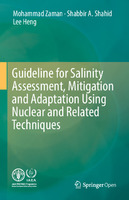Guideline for Salinity Assessment, Mitigation and Adaptation Using Nuclear and Related Techniques
| dc.contributor.author | Zaman, Mohammad | |
| dc.contributor.author | Shahid, Shabbir A. | |
| dc.contributor.author | Heng, Lee | |
| dc.date.accessioned | 2020-03-18 13:36:15 | |
| dc.date.accessioned | 2020-04-01T08:56:34Z | |
| dc.date.available | 2020-04-01T08:56:34Z | |
| dc.date.issued | 2018 | |
| dc.identifier | 1007237 | |
| dc.identifier.uri | http://library.oapen.org/handle/20.500.12657/22924 | |
| dc.description.abstract | This open access book is an outcome of the collaboration between the Soil and Water Management & Crop Nutrition Section, Joint FAO/IAEA Division of Nuclear Techniques in Food and Agriculture, Department of Nuclear Sciences and Applications, International Atomic Energy Agency (IAEA), Vienna, Austria, and Dr. Shabbir A Shahid, Senior Salinity Management Expert, Freelancer based in United Arab Emirates.The objective of this book is to develop protocols for salinity and sodicity assessment and develop mitigation and adaptation measures to use saline and sodic soils sustainably. The focus is on important issues related to salinity and sodicity and to describe these in an easy and user friendly way. The information has been compiled from the latest published literature and from the authors’ publications specific to the subject matter. The book consists of six chapters. Chapter 1 introduces the terms salinity and sodicity and describes various salinity classification systems commonly used around the world. Chapter 2 reviews global distribution of salinization and socioeconomic aspects related to salinity and crop production. Chapters 3 covers comprehensively salinity and sodicity adaptation and mitigation options including physical, chemical, hydrological and biological methods. Chapter 4 discusses the efforts that have been made to demonstrate the development of soil salinity zones under different irrigation systems. Chapter 5 discusses the quality of irrigation water, boron toxicity and relative tolerance to boron, the effects of chlorides on crops. Chapter 6 introduces the role of nuclear techniques in saline agriculture. | |
| dc.language | English | |
| dc.subject.classification | thema EDItEUR::P Mathematics and Science::PS Biology, life sciences::PST Botany and plant sciences | en_US |
| dc.subject.classification | thema EDItEUR::R Earth Sciences, Geography, Environment, Planning::RB Earth sciences::RBG Geology, geomorphology and the lithosphere::RBGB Sedimentology and pedology | en_US |
| dc.subject.classification | thema EDItEUR::R Earth Sciences, Geography, Environment, Planning::RN The environment::RNF Environmental management | en_US |
| dc.subject.classification | thema EDItEUR::T Technology, Engineering, Agriculture, Industrial processes::TQ Environmental science, engineering and technology::TQS Sanitary and municipal engineering::TQSW Water supply and treatment | en_US |
| dc.subject.classification | thema EDItEUR::T Technology, Engineering, Agriculture, Industrial processes::TV Agriculture and farming::TVB Agricultural science | en_US |
| dc.subject.other | Environment | |
| dc.subject.other | Soil science | |
| dc.subject.other | Soil conservation | |
| dc.subject.other | Water quality | |
| dc.subject.other | Water pollution | |
| dc.subject.other | Agriculture | |
| dc.subject.other | Plant science | |
| dc.subject.other | Botany | |
| dc.subject.other | Environmental management | |
| dc.title | Guideline for Salinity Assessment, Mitigation and Adaptation Using Nuclear and Related Techniques | |
| dc.type | book | |
| oapen.identifier.doi | 10.1007/978-3-319-96190-3 | |
| oapen.relation.isPublishedBy | 6c6992af-b843-4f46-859c-f6e9998e40d5 | |
| oapen.pages | 164 | |
| oapen.place.publication | Cham |

